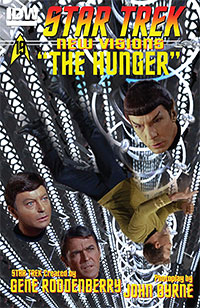I play Alexander Courage’s original Star Trek theme music in the background every time I read a copy of John Byrne’s Star Trek: New Visions.
It may sound a little extreme, but I think that’s the only thing that’s missing from the visual extravaganza of Trek involved in reading this book. After all, when you consider the visual accuracy and respectful homage to Gene Roddenberry’s original vision, the reader is lacking for nothing as she visually explores the familiar settings of the USS Enterprise in Byrne’s brilliant and novel adventures.
If you know an artist, you also know about the mindset of one. An artist is committed to an image in their mind that is as close to the original source as their perspective allows it. Philosophically speaking, it’s the pursuit of truth and Byrne’s photographic realization and rebirth of this series in this book is about as close to absolute truth as one can get in a fictional story.
There’s also the nostalgia effect this creates as well. I may be getting older, but my love for the Original Series has never diminished. Though I celebrate new incarnations of Trek, this series will always be my first love. From the times when I would stay up late, hoping for a stay of the regular bedtime routine from my parents by declaring “…but Star Trek’s on!” to those other occasions when I would record the series on my old tape recorder and listen to them for a week until it was time to record the new episode. Byrne has gifted readers like me with a chance to visually relive this series and I enjoy every page.
Star Trek: New Visions #19, titled “The Hunger,” has all the typical hallmarks of an episode on a deep-space exploratory mission: we read some philosophical musings from McCoy that are countered by an analytical retort from Spock. In the background, Kirk observes the banter with a playful expression and by the next frame, something unusual registers on the long-range scanners and ultimately, on a planet in the nearby vicinity.
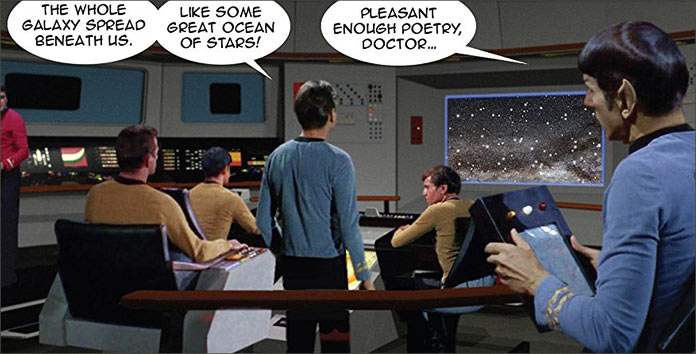
As we continue with the story, an unusual type of energy signature has been detected. When the inevitable landing party investigates, they experience a feeling of apathy and sluggishness. It’s an effect of the energy they detected earlier and then discover that it has traveled in a pattern of planets, one after another. It’s up to the Enterprise to investigate — and just like that, we’re off on another adventure and one that we could expect from any of the 1966 writers.
Later McCoy suggests to Spock that perhaps the planet is missing something called “Leiber-Kurtzberg” energy, a likely reference to famed Marvel Comics legends Stan Lee and Jack Kirby. It’s the type of energy that measures the amount of life force a planet has. Spock, for once, does not dismiss McCoy’s notion and the ship follows the pattern until they discover a planet-sized spacecraft that has been consuming the life-force of all these planets.
Kirk and a landing party explore the spacecraft and discover several anomalies. While I won’t go into the full details of what these things are, Kirk finds himself a prisoner of this malevolent force and the rest of the crew now have to both rescue the captain and somehow stop this entity from endangering the more populated regions of the galaxy.
It’s the subtle stuff that Byrne doesn’t get enough credit for. The shading, background imaging, in addition to the new images he creates that that allow for the nuances of the original series to be subliminally appreciated by the reader. All of this goes hand in hand with the overt stuff of his craft: the writing, the pacing of the story as well as the lay-out of the photo-images to properly describe the plot.
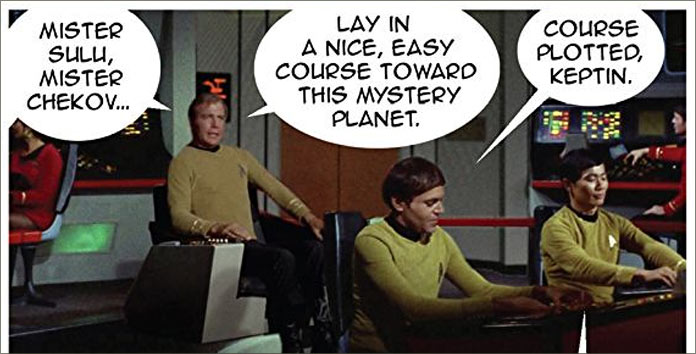
For example, the landing party scene is clearly taken from episodes that have involved Chekov, McCoy, Kirk, Spock and any anonymous redshirt. Yet Byrne has to find those images, appropriate poses, then splice them into a completely originally designed backdrop. Oh – and the dialogue has to get written and placed in there too.
He has received criticism for not simply drawing his book. I argue that he is, just in a different medium and it’s one that Byrne fans are not used to seeing. He’s creating new 3D models for his stories all the time. The planetary object the Enterprise encounters is completely original, as are its settings when Kirk and his landing party set down to explore it. Also, Kirk’s encounter afterwards is also quite well displayed and I had to say that it was a very artfully done piece of staging. You’ll see what I mean when you read the book.
The new holographic display in Engineering that we see in this story was created some issues ago, yet this is brand new art for not only the series but for Byrne as well. Moreover, it blends perfectly with the series and does not appear out of place. That’s a tall order for Byrne to accomplish. It’s one thing to be able to recreate computer generated images from scratch, but it’s another to make them seem like they fit into the milieu.
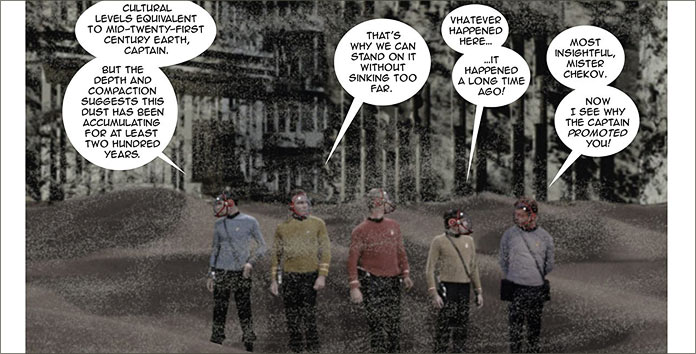
Speaking of Engineering, the extra officers in the main area waiting to greet Scotty were also a feature of this unseen effort. It also begs certain questions: are these extras actors that Byrne has photographed or are they also background characters whose images are part of the stock footage that Byrne is allowed to access? In either case, this too is work that is in addition to the usual labours involved with creating a comic.
It’s the relaxed, care-free posturing of the characters in these images that can’t be overlooked. While we may take them for granted as the types of poses that we would come to expect from the characters, we have to remember that this is not something that happens effortlessly or by chance. I don’t know how many hours it took for Byrne to research the pictures with the exact type of facial expression or stance he would need for these frames, but I can be sure that they must have been numerous.
Like I said, I love to play the original theme music in the background when I read these books. It adds to the ambiance and it’s the only thing that’s missing from the experience.
Maybe that can be Byrne’s next challenge?
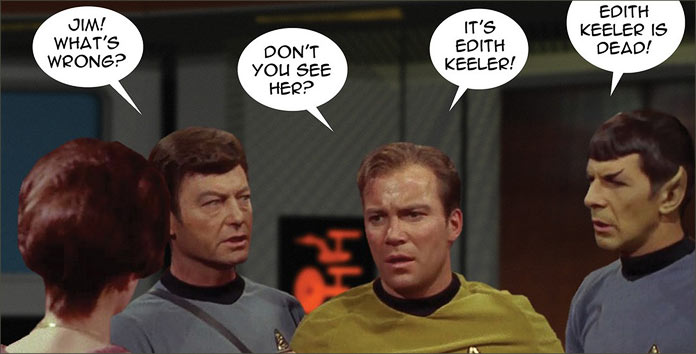
John Byrne’s New Visions series hits its landmark 20th issue with “Isolation,” where Kirk and crew find themselves trapped on empty versions of the Enterprise. Captain Kirk has found himself all alone on the Enterprise before — but what happens when each individual member of the crew finds themselves in a similar state?
Find out in our review next year!
![]()

